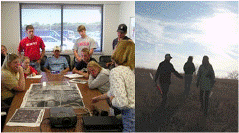Environmental and Sustainability Studies Program

Department of Environmental Studies: Undergraduate Student Theses
Date of this Version
Spring 5-2013
Document Type
Thesis
Abstract
With human population projection estimates pointing to nine billion by year 2050, the importance of maintaining Earth’s basic ecosystem services has quickly become increasingly important. Supporting this expanding population with enough food, fiber, and fuel has intensified demands on agricultural land and other natural resources (Haile-Mariam et al., 2008). Intensive agriculture, coupled with an increase in nitrogen (N) fertilizer use, has contributed significantly to the elevation of atmospheric greenhouse gases (GHGs), including carbon dioxide (CO2), methane (CH4), and nitrous oxide (N2O)(Haile-Mariam et al., 2008). These three GHGs differ noticeably in their atmospheric concentrations, residence time in the atmosphere, and global warming potential (GWP) (Leibig et al., 2012). Of the three GHGs, N2O is present in the lowest atmospheric concentrations but has the greatest GWP, at 298 times that of CO2 (IPCC, 2007; NOAA, 2011).
The objective of this research is to characterize soil N2O emissions following one irrigation event at full irrigation or deficit irrigation rates in a continuous corn, no-tillage (till) system under different N fertilization treatments (commercial N, cattle manure). Full irrigation is defined as the amount of water needed to meet 100% of a plant’s water needs, and the deficit irrigation rate used here represents 60% of full irrigation. Employing best management practices (BMPs), as it pertains to agricultural irrigation levels, is important in assisting in the mitigation of the GHGs listed.

